Strategic Management and Technology Alignment
VerifiedAdded on 2020/04/21
|12
|3565
|112
AI Summary
This assignment delves into the crucial relationship between strategic management and technology implementation. It examines theoretical frameworks like 'techno-change alignment' and 'strategy as practice' to understand how organizations effectively integrate technology into their overall strategies. The analysis draws upon case studies and research to demonstrate practical applications of these concepts in real-world organizational change.
Contribute Materials
Your contribution can guide someone’s learning journey. Share your
documents today.
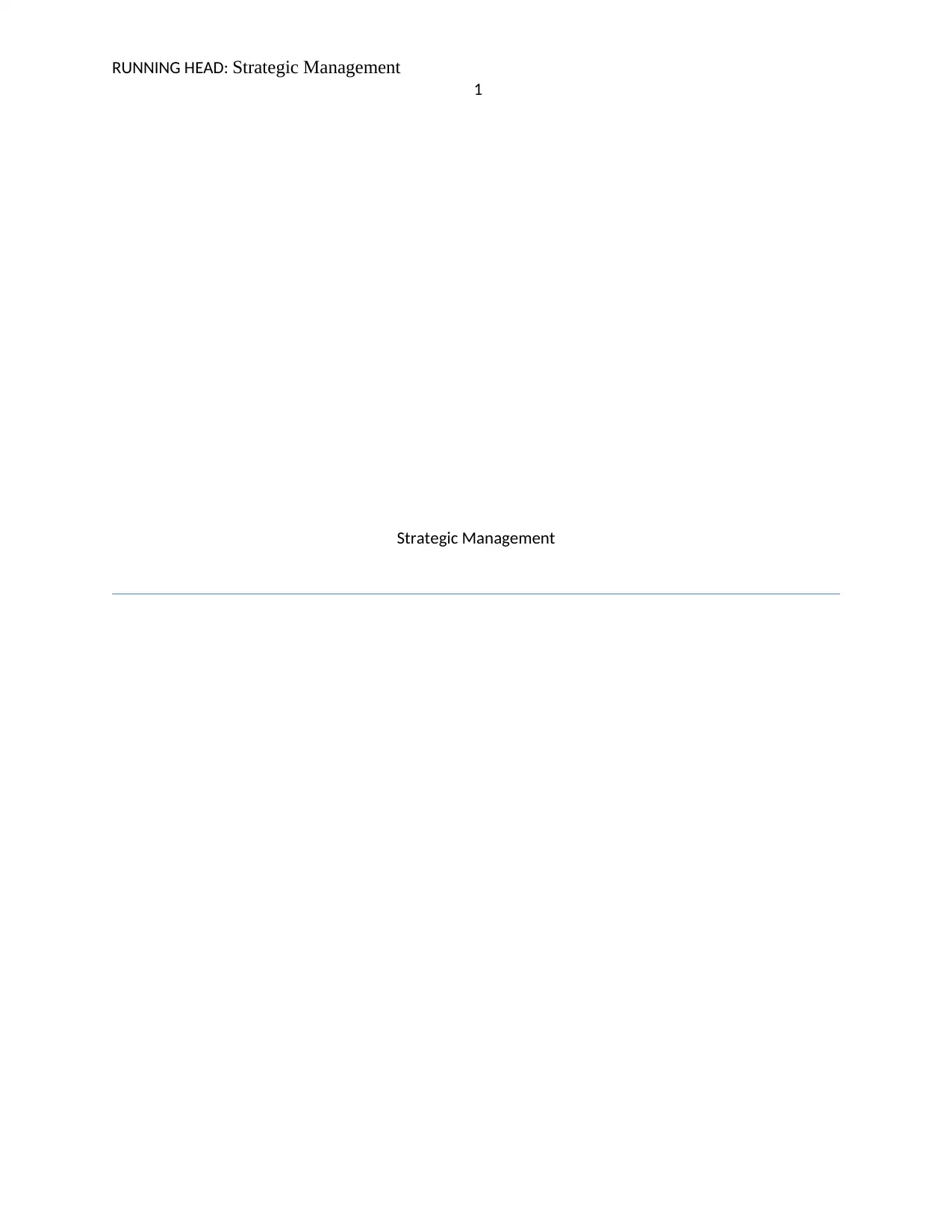
RUNNING HEAD: Strategic Management
1
Strategic Management
1
Strategic Management
Secure Best Marks with AI Grader
Need help grading? Try our AI Grader for instant feedback on your assignments.
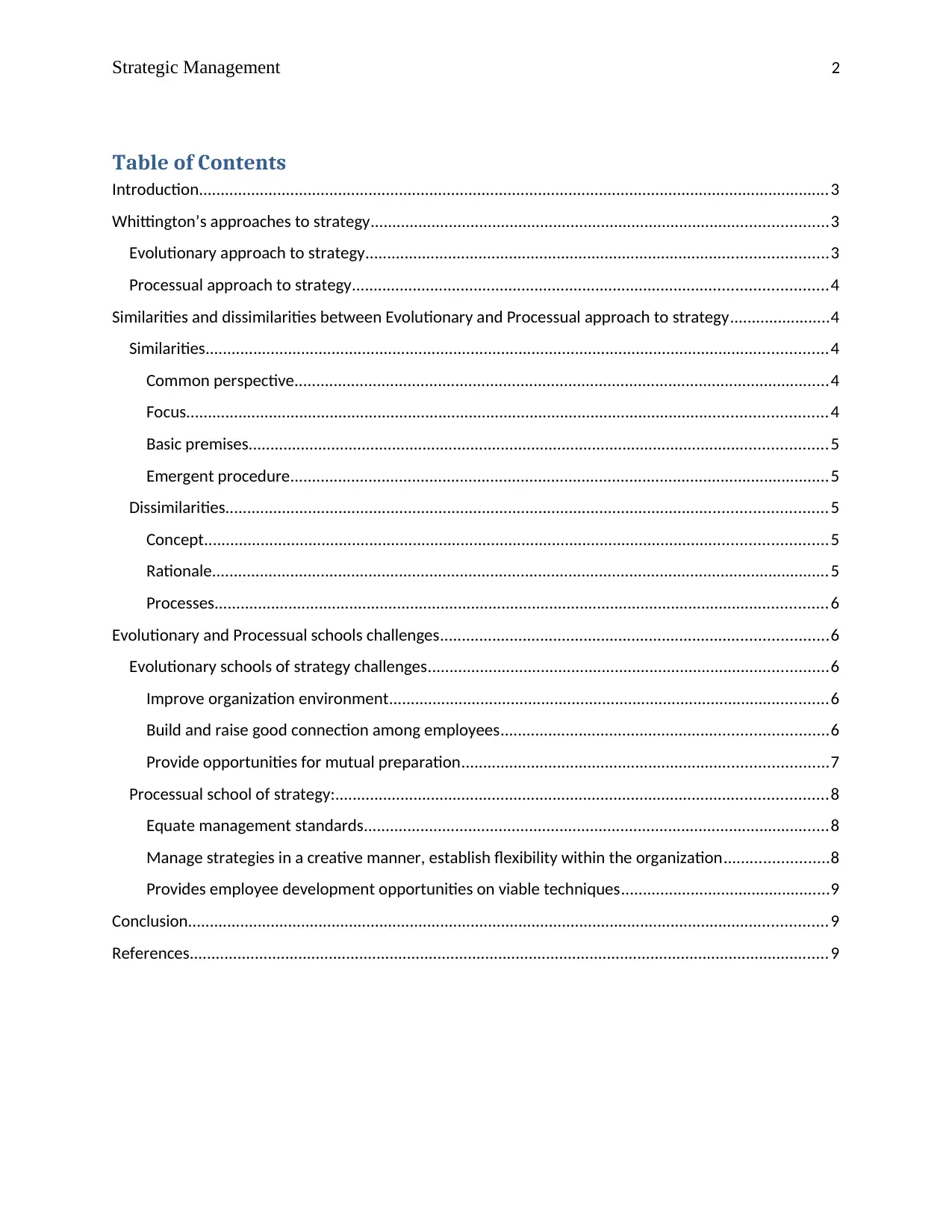
Strategic Management 2
Table of Contents
Introduction.................................................................................................................................................3
Whittington’s approaches to strategy.........................................................................................................3
Evolutionary approach to strategy..........................................................................................................3
Processual approach to strategy.............................................................................................................4
Similarities and dissimilarities between Evolutionary and Processual approach to strategy.......................4
Similarities...............................................................................................................................................4
Common perspective...........................................................................................................................4
Focus...................................................................................................................................................4
Basic premises.....................................................................................................................................5
Emergent procedure............................................................................................................................5
Dissimilarities..........................................................................................................................................5
Concept...............................................................................................................................................5
Rationale..............................................................................................................................................5
Processes.............................................................................................................................................6
Evolutionary and Processual schools challenges.........................................................................................6
Evolutionary schools of strategy challenges............................................................................................6
Improve organization environment.....................................................................................................6
Build and raise good connection among employees...........................................................................6
Provide opportunities for mutual preparation....................................................................................7
Processual school of strategy:.................................................................................................................8
Equate management standards...........................................................................................................8
Manage strategies in a creative manner, establish flexibility within the organization........................8
Provides employee development opportunities on viable techniques................................................9
Conclusion...................................................................................................................................................9
References...................................................................................................................................................9
Table of Contents
Introduction.................................................................................................................................................3
Whittington’s approaches to strategy.........................................................................................................3
Evolutionary approach to strategy..........................................................................................................3
Processual approach to strategy.............................................................................................................4
Similarities and dissimilarities between Evolutionary and Processual approach to strategy.......................4
Similarities...............................................................................................................................................4
Common perspective...........................................................................................................................4
Focus...................................................................................................................................................4
Basic premises.....................................................................................................................................5
Emergent procedure............................................................................................................................5
Dissimilarities..........................................................................................................................................5
Concept...............................................................................................................................................5
Rationale..............................................................................................................................................5
Processes.............................................................................................................................................6
Evolutionary and Processual schools challenges.........................................................................................6
Evolutionary schools of strategy challenges............................................................................................6
Improve organization environment.....................................................................................................6
Build and raise good connection among employees...........................................................................6
Provide opportunities for mutual preparation....................................................................................7
Processual school of strategy:.................................................................................................................8
Equate management standards...........................................................................................................8
Manage strategies in a creative manner, establish flexibility within the organization........................8
Provides employee development opportunities on viable techniques................................................9
Conclusion...................................................................................................................................................9
References...................................................................................................................................................9
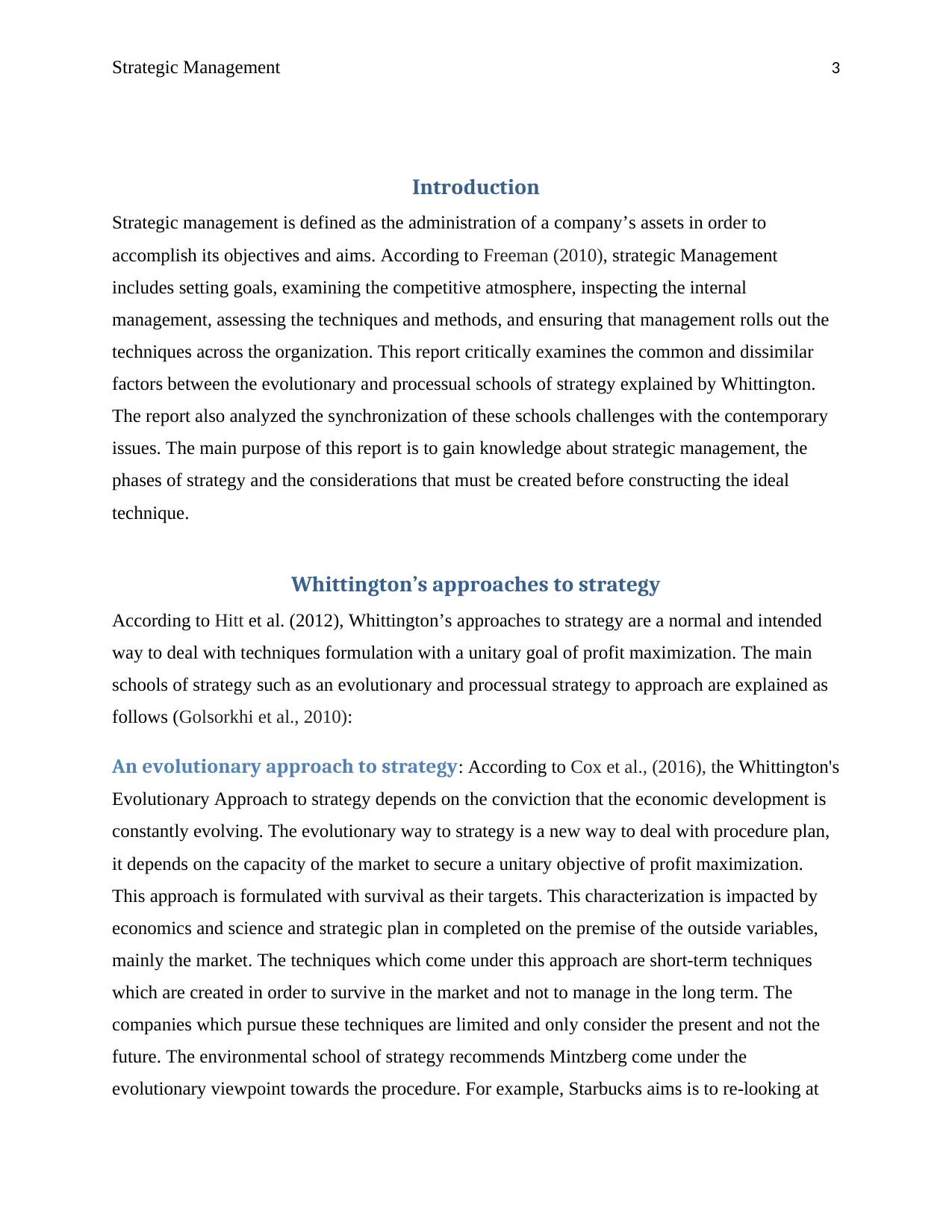
Strategic Management 3
Introduction
Strategic management is defined as the administration of a company’s assets in order to
accomplish its objectives and aims. According to Freeman (2010), strategic Management
includes setting goals, examining the competitive atmosphere, inspecting the internal
management, assessing the techniques and methods, and ensuring that management rolls out the
techniques across the organization. This report critically examines the common and dissimilar
factors between the evolutionary and processual schools of strategy explained by Whittington.
The report also analyzed the synchronization of these schools challenges with the contemporary
issues. The main purpose of this report is to gain knowledge about strategic management, the
phases of strategy and the considerations that must be created before constructing the ideal
technique.
Whittington’s approaches to strategy
According to Hitt et al. (2012), Whittington’s approaches to strategy are a normal and intended
way to deal with techniques formulation with a unitary goal of profit maximization. The main
schools of strategy such as an evolutionary and processual strategy to approach are explained as
follows (Golsorkhi et al., 2010):
An evolutionary approach to strategy: According to Cox et al., (2016), the Whittington's
Evolutionary Approach to strategy depends on the conviction that the economic development is
constantly evolving. The evolutionary way to strategy is a new way to deal with procedure plan,
it depends on the capacity of the market to secure a unitary objective of profit maximization.
This approach is formulated with survival as their targets. This characterization is impacted by
economics and science and strategic plan in completed on the premise of the outside variables,
mainly the market. The techniques which come under this approach are short-term techniques
which are created in order to survive in the market and not to manage in the long term. The
companies which pursue these techniques are limited and only consider the present and not the
future. The environmental school of strategy recommends Mintzberg come under the
evolutionary viewpoint towards the procedure. For example, Starbucks aims is to re-looking at
Introduction
Strategic management is defined as the administration of a company’s assets in order to
accomplish its objectives and aims. According to Freeman (2010), strategic Management
includes setting goals, examining the competitive atmosphere, inspecting the internal
management, assessing the techniques and methods, and ensuring that management rolls out the
techniques across the organization. This report critically examines the common and dissimilar
factors between the evolutionary and processual schools of strategy explained by Whittington.
The report also analyzed the synchronization of these schools challenges with the contemporary
issues. The main purpose of this report is to gain knowledge about strategic management, the
phases of strategy and the considerations that must be created before constructing the ideal
technique.
Whittington’s approaches to strategy
According to Hitt et al. (2012), Whittington’s approaches to strategy are a normal and intended
way to deal with techniques formulation with a unitary goal of profit maximization. The main
schools of strategy such as an evolutionary and processual strategy to approach are explained as
follows (Golsorkhi et al., 2010):
An evolutionary approach to strategy: According to Cox et al., (2016), the Whittington's
Evolutionary Approach to strategy depends on the conviction that the economic development is
constantly evolving. The evolutionary way to strategy is a new way to deal with procedure plan,
it depends on the capacity of the market to secure a unitary objective of profit maximization.
This approach is formulated with survival as their targets. This characterization is impacted by
economics and science and strategic plan in completed on the premise of the outside variables,
mainly the market. The techniques which come under this approach are short-term techniques
which are created in order to survive in the market and not to manage in the long term. The
companies which pursue these techniques are limited and only consider the present and not the
future. The environmental school of strategy recommends Mintzberg come under the
evolutionary viewpoint towards the procedure. For example, Starbucks aims is to re-looking at
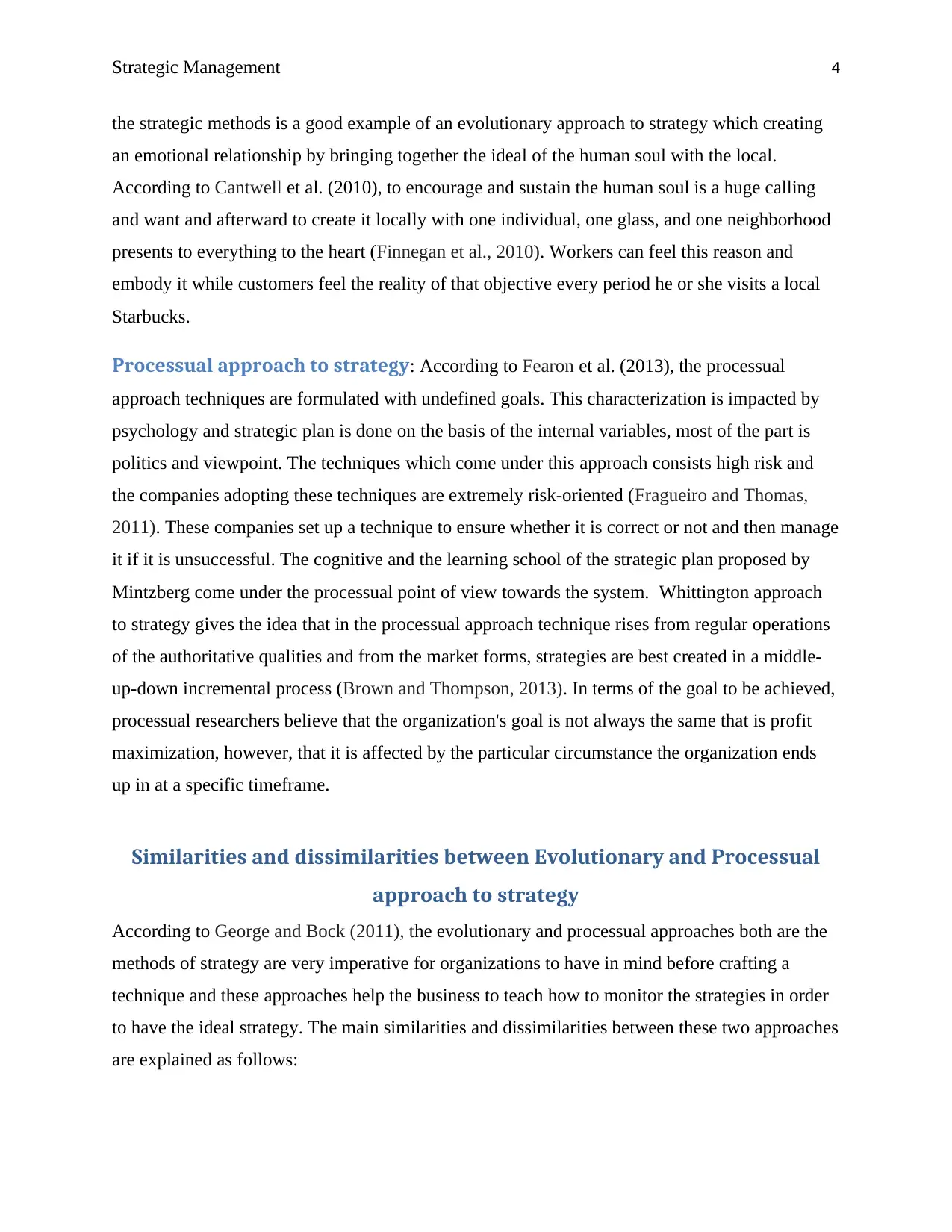
Strategic Management 4
the strategic methods is a good example of an evolutionary approach to strategy which creating
an emotional relationship by bringing together the ideal of the human soul with the local.
According to Cantwell et al. (2010), to encourage and sustain the human soul is a huge calling
and want and afterward to create it locally with one individual, one glass, and one neighborhood
presents to everything to the heart (Finnegan et al., 2010). Workers can feel this reason and
embody it while customers feel the reality of that objective every period he or she visits a local
Starbucks.
Processual approach to strategy: According to Fearon et al. (2013), the processual
approach techniques are formulated with undefined goals. This characterization is impacted by
psychology and strategic plan is done on the basis of the internal variables, most of the part is
politics and viewpoint. The techniques which come under this approach consists high risk and
the companies adopting these techniques are extremely risk-oriented (Fragueiro and Thomas,
2011). These companies set up a technique to ensure whether it is correct or not and then manage
it if it is unsuccessful. The cognitive and the learning school of the strategic plan proposed by
Mintzberg come under the processual point of view towards the system. Whittington approach
to strategy gives the idea that in the processual approach technique rises from regular operations
of the authoritative qualities and from the market forms, strategies are best created in a middle-
up-down incremental process (Brown and Thompson, 2013). In terms of the goal to be achieved,
processual researchers believe that the organization's goal is not always the same that is profit
maximization, however, that it is affected by the particular circumstance the organization ends
up in at a specific timeframe.
Similarities and dissimilarities between Evolutionary and Processual
approach to strategy
According to George and Bock (2011), the evolutionary and processual approaches both are the
methods of strategy are very imperative for organizations to have in mind before crafting a
technique and these approaches help the business to teach how to monitor the strategies in order
to have the ideal strategy. The main similarities and dissimilarities between these two approaches
are explained as follows:
the strategic methods is a good example of an evolutionary approach to strategy which creating
an emotional relationship by bringing together the ideal of the human soul with the local.
According to Cantwell et al. (2010), to encourage and sustain the human soul is a huge calling
and want and afterward to create it locally with one individual, one glass, and one neighborhood
presents to everything to the heart (Finnegan et al., 2010). Workers can feel this reason and
embody it while customers feel the reality of that objective every period he or she visits a local
Starbucks.
Processual approach to strategy: According to Fearon et al. (2013), the processual
approach techniques are formulated with undefined goals. This characterization is impacted by
psychology and strategic plan is done on the basis of the internal variables, most of the part is
politics and viewpoint. The techniques which come under this approach consists high risk and
the companies adopting these techniques are extremely risk-oriented (Fragueiro and Thomas,
2011). These companies set up a technique to ensure whether it is correct or not and then manage
it if it is unsuccessful. The cognitive and the learning school of the strategic plan proposed by
Mintzberg come under the processual point of view towards the system. Whittington approach
to strategy gives the idea that in the processual approach technique rises from regular operations
of the authoritative qualities and from the market forms, strategies are best created in a middle-
up-down incremental process (Brown and Thompson, 2013). In terms of the goal to be achieved,
processual researchers believe that the organization's goal is not always the same that is profit
maximization, however, that it is affected by the particular circumstance the organization ends
up in at a specific timeframe.
Similarities and dissimilarities between Evolutionary and Processual
approach to strategy
According to George and Bock (2011), the evolutionary and processual approaches both are the
methods of strategy are very imperative for organizations to have in mind before crafting a
technique and these approaches help the business to teach how to monitor the strategies in order
to have the ideal strategy. The main similarities and dissimilarities between these two approaches
are explained as follows:
Secure Best Marks with AI Grader
Need help grading? Try our AI Grader for instant feedback on your assignments.
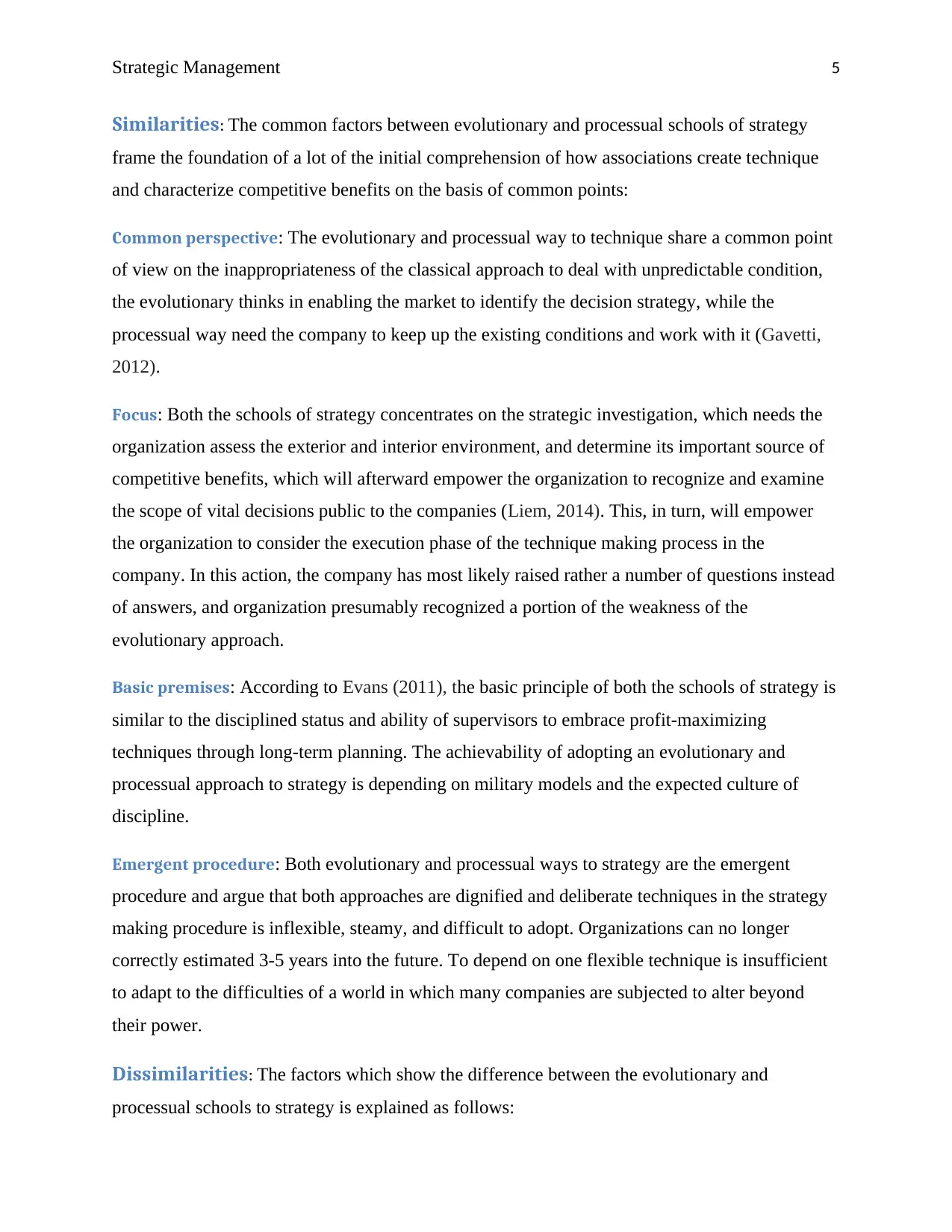
Strategic Management 5
Similarities: The common factors between evolutionary and processual schools of strategy
frame the foundation of a lot of the initial comprehension of how associations create technique
and characterize competitive benefits on the basis of common points:
Common perspective: The evolutionary and processual way to technique share a common point
of view on the inappropriateness of the classical approach to deal with unpredictable condition,
the evolutionary thinks in enabling the market to identify the decision strategy, while the
processual way need the company to keep up the existing conditions and work with it (Gavetti,
2012).
Focus: Both the schools of strategy concentrates on the strategic investigation, which needs the
organization assess the exterior and interior environment, and determine its important source of
competitive benefits, which will afterward empower the organization to recognize and examine
the scope of vital decisions public to the companies (Liem, 2014). This, in turn, will empower
the organization to consider the execution phase of the technique making process in the
company. In this action, the company has most likely raised rather a number of questions instead
of answers, and organization presumably recognized a portion of the weakness of the
evolutionary approach.
Basic premises: According to Evans (2011), the basic principle of both the schools of strategy is
similar to the disciplined status and ability of supervisors to embrace profit-maximizing
techniques through long-term planning. The achievability of adopting an evolutionary and
processual approach to strategy is depending on military models and the expected culture of
discipline.
Emergent procedure: Both evolutionary and processual ways to strategy are the emergent
procedure and argue that both approaches are dignified and deliberate techniques in the strategy
making procedure is inflexible, steamy, and difficult to adopt. Organizations can no longer
correctly estimated 3-5 years into the future. To depend on one flexible technique is insufficient
to adapt to the difficulties of a world in which many companies are subjected to alter beyond
their power.
Dissimilarities: The factors which show the difference between the evolutionary and
processual schools to strategy is explained as follows:
Similarities: The common factors between evolutionary and processual schools of strategy
frame the foundation of a lot of the initial comprehension of how associations create technique
and characterize competitive benefits on the basis of common points:
Common perspective: The evolutionary and processual way to technique share a common point
of view on the inappropriateness of the classical approach to deal with unpredictable condition,
the evolutionary thinks in enabling the market to identify the decision strategy, while the
processual way need the company to keep up the existing conditions and work with it (Gavetti,
2012).
Focus: Both the schools of strategy concentrates on the strategic investigation, which needs the
organization assess the exterior and interior environment, and determine its important source of
competitive benefits, which will afterward empower the organization to recognize and examine
the scope of vital decisions public to the companies (Liem, 2014). This, in turn, will empower
the organization to consider the execution phase of the technique making process in the
company. In this action, the company has most likely raised rather a number of questions instead
of answers, and organization presumably recognized a portion of the weakness of the
evolutionary approach.
Basic premises: According to Evans (2011), the basic principle of both the schools of strategy is
similar to the disciplined status and ability of supervisors to embrace profit-maximizing
techniques through long-term planning. The achievability of adopting an evolutionary and
processual approach to strategy is depending on military models and the expected culture of
discipline.
Emergent procedure: Both evolutionary and processual ways to strategy are the emergent
procedure and argue that both approaches are dignified and deliberate techniques in the strategy
making procedure is inflexible, steamy, and difficult to adopt. Organizations can no longer
correctly estimated 3-5 years into the future. To depend on one flexible technique is insufficient
to adapt to the difficulties of a world in which many companies are subjected to alter beyond
their power.
Dissimilarities: The factors which show the difference between the evolutionary and
processual schools to strategy is explained as follows:
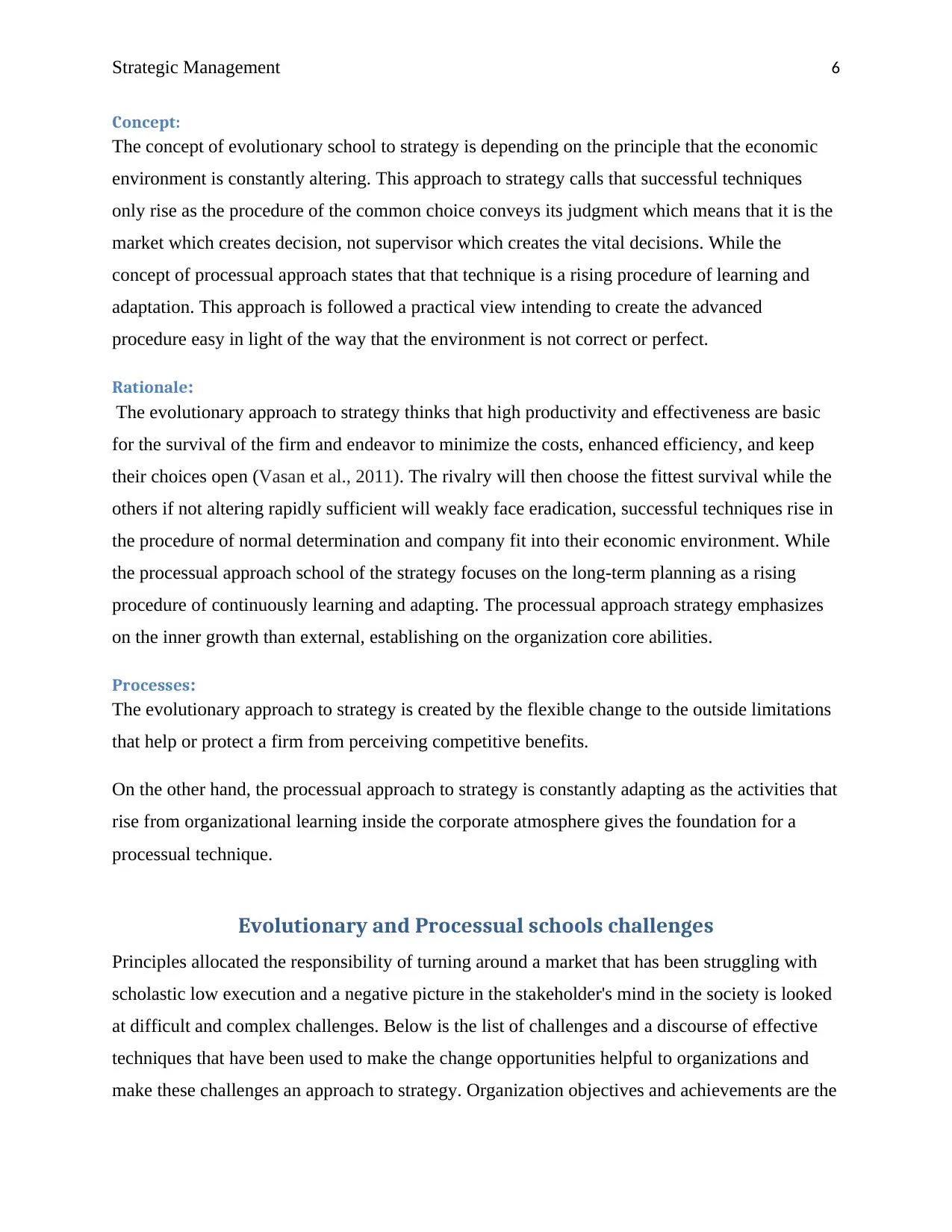
Strategic Management 6
Concept:
The concept of evolutionary school to strategy is depending on the principle that the economic
environment is constantly altering. This approach to strategy calls that successful techniques
only rise as the procedure of the common choice conveys its judgment which means that it is the
market which creates decision, not supervisor which creates the vital decisions. While the
concept of processual approach states that that technique is a rising procedure of learning and
adaptation. This approach is followed a practical view intending to create the advanced
procedure easy in light of the way that the environment is not correct or perfect.
Rationale:
The evolutionary approach to strategy thinks that high productivity and effectiveness are basic
for the survival of the firm and endeavor to minimize the costs, enhanced efficiency, and keep
their choices open (Vasan et al., 2011). The rivalry will then choose the fittest survival while the
others if not altering rapidly sufficient will weakly face eradication, successful techniques rise in
the procedure of normal determination and company fit into their economic environment. While
the processual approach school of the strategy focuses on the long-term planning as a rising
procedure of continuously learning and adapting. The processual approach strategy emphasizes
on the inner growth than external, establishing on the organization core abilities.
Processes:
The evolutionary approach to strategy is created by the flexible change to the outside limitations
that help or protect a firm from perceiving competitive benefits.
On the other hand, the processual approach to strategy is constantly adapting as the activities that
rise from organizational learning inside the corporate atmosphere gives the foundation for a
processual technique.
Evolutionary and Processual schools challenges
Principles allocated the responsibility of turning around a market that has been struggling with
scholastic low execution and a negative picture in the stakeholder's mind in the society is looked
at difficult and complex challenges. Below is the list of challenges and a discourse of effective
techniques that have been used to make the change opportunities helpful to organizations and
make these challenges an approach to strategy. Organization objectives and achievements are the
Concept:
The concept of evolutionary school to strategy is depending on the principle that the economic
environment is constantly altering. This approach to strategy calls that successful techniques
only rise as the procedure of the common choice conveys its judgment which means that it is the
market which creates decision, not supervisor which creates the vital decisions. While the
concept of processual approach states that that technique is a rising procedure of learning and
adaptation. This approach is followed a practical view intending to create the advanced
procedure easy in light of the way that the environment is not correct or perfect.
Rationale:
The evolutionary approach to strategy thinks that high productivity and effectiveness are basic
for the survival of the firm and endeavor to minimize the costs, enhanced efficiency, and keep
their choices open (Vasan et al., 2011). The rivalry will then choose the fittest survival while the
others if not altering rapidly sufficient will weakly face eradication, successful techniques rise in
the procedure of normal determination and company fit into their economic environment. While
the processual approach school of the strategy focuses on the long-term planning as a rising
procedure of continuously learning and adapting. The processual approach strategy emphasizes
on the inner growth than external, establishing on the organization core abilities.
Processes:
The evolutionary approach to strategy is created by the flexible change to the outside limitations
that help or protect a firm from perceiving competitive benefits.
On the other hand, the processual approach to strategy is constantly adapting as the activities that
rise from organizational learning inside the corporate atmosphere gives the foundation for a
processual technique.
Evolutionary and Processual schools challenges
Principles allocated the responsibility of turning around a market that has been struggling with
scholastic low execution and a negative picture in the stakeholder's mind in the society is looked
at difficult and complex challenges. Below is the list of challenges and a discourse of effective
techniques that have been used to make the change opportunities helpful to organizations and
make these challenges an approach to strategy. Organization objectives and achievements are the
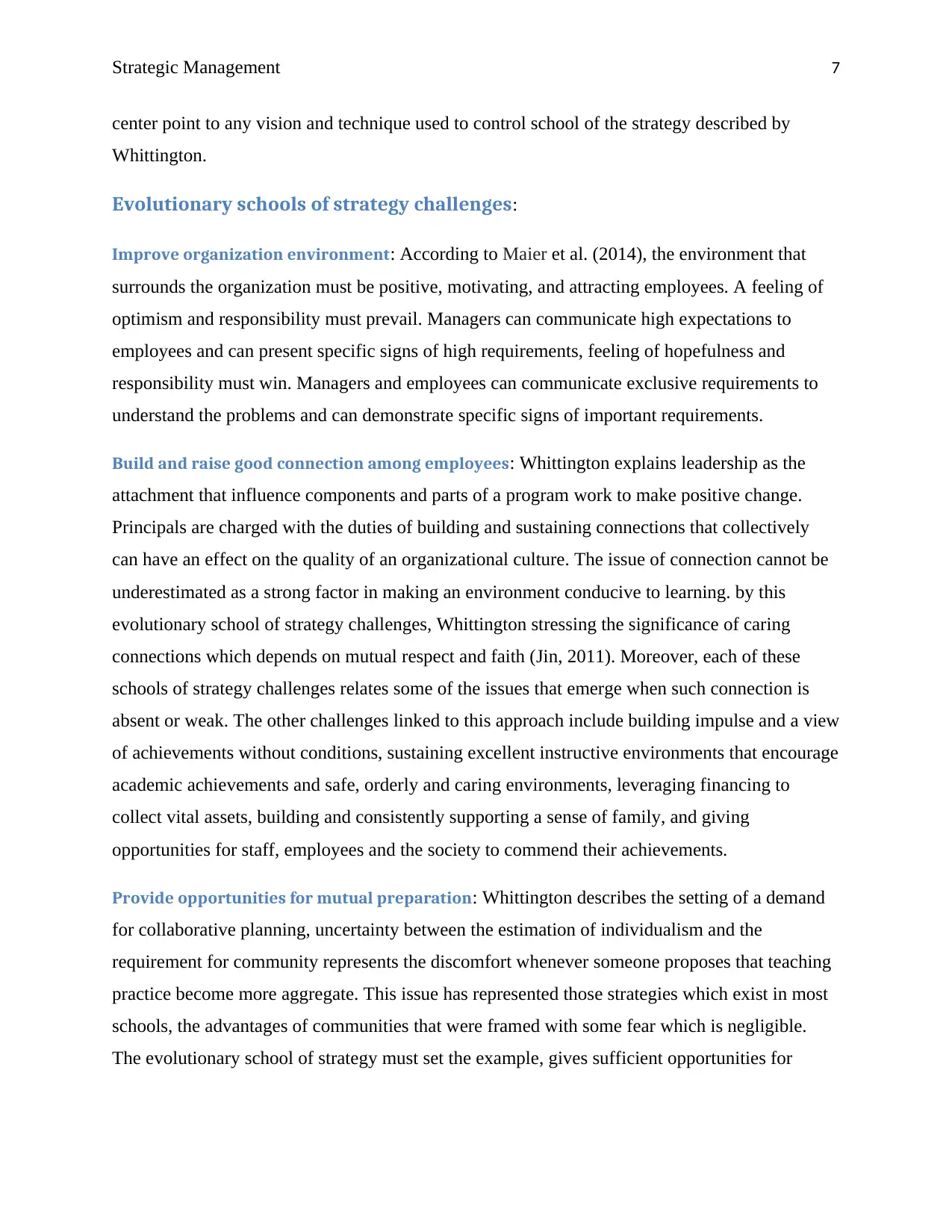
Strategic Management 7
center point to any vision and technique used to control school of the strategy described by
Whittington.
Evolutionary schools of strategy challenges:
Improve organization environment: According to Maier et al. (2014), the environment that
surrounds the organization must be positive, motivating, and attracting employees. A feeling of
optimism and responsibility must prevail. Managers can communicate high expectations to
employees and can present specific signs of high requirements, feeling of hopefulness and
responsibility must win. Managers and employees can communicate exclusive requirements to
understand the problems and can demonstrate specific signs of important requirements.
Build and raise good connection among employees: Whittington explains leadership as the
attachment that influence components and parts of a program work to make positive change.
Principals are charged with the duties of building and sustaining connections that collectively
can have an effect on the quality of an organizational culture. The issue of connection cannot be
underestimated as a strong factor in making an environment conducive to learning. by this
evolutionary school of strategy challenges, Whittington stressing the significance of caring
connections which depends on mutual respect and faith (Jin, 2011). Moreover, each of these
schools of strategy challenges relates some of the issues that emerge when such connection is
absent or weak. The other challenges linked to this approach include building impulse and a view
of achievements without conditions, sustaining excellent instructive environments that encourage
academic achievements and safe, orderly and caring environments, leveraging financing to
collect vital assets, building and consistently supporting a sense of family, and giving
opportunities for staff, employees and the society to commend their achievements.
Provide opportunities for mutual preparation: Whittington describes the setting of a demand
for collaborative planning, uncertainty between the estimation of individualism and the
requirement for community represents the discomfort whenever someone proposes that teaching
practice become more aggregate. This issue has represented those strategies which exist in most
schools, the advantages of communities that were framed with some fear which is negligible.
The evolutionary school of strategy must set the example, gives sufficient opportunities for
center point to any vision and technique used to control school of the strategy described by
Whittington.
Evolutionary schools of strategy challenges:
Improve organization environment: According to Maier et al. (2014), the environment that
surrounds the organization must be positive, motivating, and attracting employees. A feeling of
optimism and responsibility must prevail. Managers can communicate high expectations to
employees and can present specific signs of high requirements, feeling of hopefulness and
responsibility must win. Managers and employees can communicate exclusive requirements to
understand the problems and can demonstrate specific signs of important requirements.
Build and raise good connection among employees: Whittington explains leadership as the
attachment that influence components and parts of a program work to make positive change.
Principals are charged with the duties of building and sustaining connections that collectively
can have an effect on the quality of an organizational culture. The issue of connection cannot be
underestimated as a strong factor in making an environment conducive to learning. by this
evolutionary school of strategy challenges, Whittington stressing the significance of caring
connections which depends on mutual respect and faith (Jin, 2011). Moreover, each of these
schools of strategy challenges relates some of the issues that emerge when such connection is
absent or weak. The other challenges linked to this approach include building impulse and a view
of achievements without conditions, sustaining excellent instructive environments that encourage
academic achievements and safe, orderly and caring environments, leveraging financing to
collect vital assets, building and consistently supporting a sense of family, and giving
opportunities for staff, employees and the society to commend their achievements.
Provide opportunities for mutual preparation: Whittington describes the setting of a demand
for collaborative planning, uncertainty between the estimation of individualism and the
requirement for community represents the discomfort whenever someone proposes that teaching
practice become more aggregate. This issue has represented those strategies which exist in most
schools, the advantages of communities that were framed with some fear which is negligible.
The evolutionary school of strategy must set the example, gives sufficient opportunities for
Paraphrase This Document
Need a fresh take? Get an instant paraphrase of this document with our AI Paraphraser
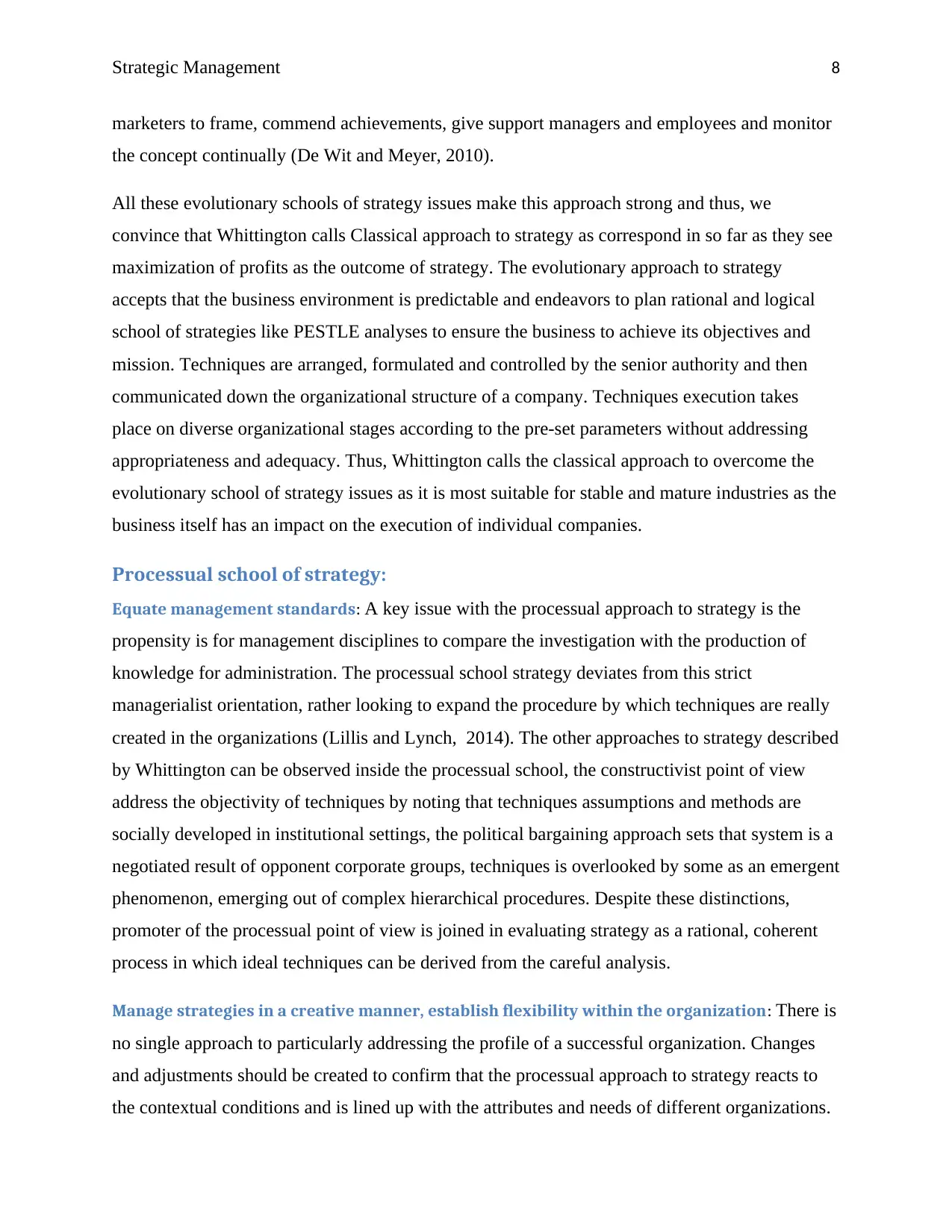
Strategic Management 8
marketers to frame, commend achievements, give support managers and employees and monitor
the concept continually (De Wit and Meyer, 2010).
All these evolutionary schools of strategy issues make this approach strong and thus, we
convince that Whittington calls Classical approach to strategy as correspond in so far as they see
maximization of profits as the outcome of strategy. The evolutionary approach to strategy
accepts that the business environment is predictable and endeavors to plan rational and logical
school of strategies like PESTLE analyses to ensure the business to achieve its objectives and
mission. Techniques are arranged, formulated and controlled by the senior authority and then
communicated down the organizational structure of a company. Techniques execution takes
place on diverse organizational stages according to the pre-set parameters without addressing
appropriateness and adequacy. Thus, Whittington calls the classical approach to overcome the
evolutionary school of strategy issues as it is most suitable for stable and mature industries as the
business itself has an impact on the execution of individual companies.
Processual school of strategy:
Equate management standards: A key issue with the processual approach to strategy is the
propensity is for management disciplines to compare the investigation with the production of
knowledge for administration. The processual school strategy deviates from this strict
managerialist orientation, rather looking to expand the procedure by which techniques are really
created in the organizations (Lillis and Lynch, 2014). The other approaches to strategy described
by Whittington can be observed inside the processual school, the constructivist point of view
address the objectivity of techniques by noting that techniques assumptions and methods are
socially developed in institutional settings, the political bargaining approach sets that system is a
negotiated result of opponent corporate groups, techniques is overlooked by some as an emergent
phenomenon, emerging out of complex hierarchical procedures. Despite these distinctions,
promoter of the processual point of view is joined in evaluating strategy as a rational, coherent
process in which ideal techniques can be derived from the careful analysis.
Manage strategies in a creative manner, establish flexibility within the organization: There is
no single approach to particularly addressing the profile of a successful organization. Changes
and adjustments should be created to confirm that the processual approach to strategy reacts to
the contextual conditions and is lined up with the attributes and needs of different organizations.
marketers to frame, commend achievements, give support managers and employees and monitor
the concept continually (De Wit and Meyer, 2010).
All these evolutionary schools of strategy issues make this approach strong and thus, we
convince that Whittington calls Classical approach to strategy as correspond in so far as they see
maximization of profits as the outcome of strategy. The evolutionary approach to strategy
accepts that the business environment is predictable and endeavors to plan rational and logical
school of strategies like PESTLE analyses to ensure the business to achieve its objectives and
mission. Techniques are arranged, formulated and controlled by the senior authority and then
communicated down the organizational structure of a company. Techniques execution takes
place on diverse organizational stages according to the pre-set parameters without addressing
appropriateness and adequacy. Thus, Whittington calls the classical approach to overcome the
evolutionary school of strategy issues as it is most suitable for stable and mature industries as the
business itself has an impact on the execution of individual companies.
Processual school of strategy:
Equate management standards: A key issue with the processual approach to strategy is the
propensity is for management disciplines to compare the investigation with the production of
knowledge for administration. The processual school strategy deviates from this strict
managerialist orientation, rather looking to expand the procedure by which techniques are really
created in the organizations (Lillis and Lynch, 2014). The other approaches to strategy described
by Whittington can be observed inside the processual school, the constructivist point of view
address the objectivity of techniques by noting that techniques assumptions and methods are
socially developed in institutional settings, the political bargaining approach sets that system is a
negotiated result of opponent corporate groups, techniques is overlooked by some as an emergent
phenomenon, emerging out of complex hierarchical procedures. Despite these distinctions,
promoter of the processual point of view is joined in evaluating strategy as a rational, coherent
process in which ideal techniques can be derived from the careful analysis.
Manage strategies in a creative manner, establish flexibility within the organization: There is
no single approach to particularly addressing the profile of a successful organization. Changes
and adjustments should be created to confirm that the processual approach to strategy reacts to
the contextual conditions and is lined up with the attributes and needs of different organizations.
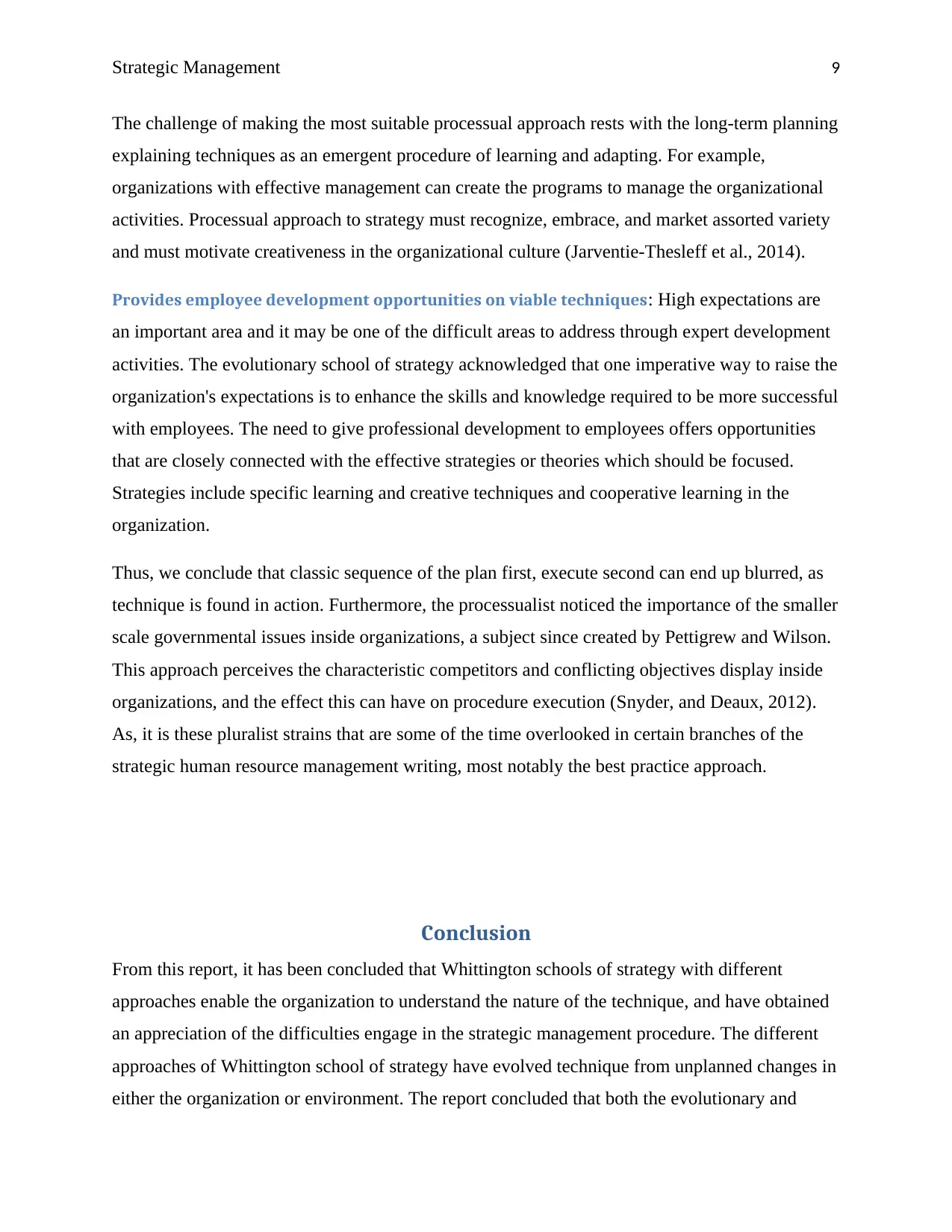
Strategic Management 9
The challenge of making the most suitable processual approach rests with the long-term planning
explaining techniques as an emergent procedure of learning and adapting. For example,
organizations with effective management can create the programs to manage the organizational
activities. Processual approach to strategy must recognize, embrace, and market assorted variety
and must motivate creativeness in the organizational culture (Jarventie-Thesleff et al., 2014).
Provides employee development opportunities on viable techniques: High expectations are
an important area and it may be one of the difficult areas to address through expert development
activities. The evolutionary school of strategy acknowledged that one imperative way to raise the
organization's expectations is to enhance the skills and knowledge required to be more successful
with employees. The need to give professional development to employees offers opportunities
that are closely connected with the effective strategies or theories which should be focused.
Strategies include specific learning and creative techniques and cooperative learning in the
organization.
Thus, we conclude that classic sequence of the plan first, execute second can end up blurred, as
technique is found in action. Furthermore, the processualist noticed the importance of the smaller
scale governmental issues inside organizations, a subject since created by Pettigrew and Wilson.
This approach perceives the characteristic competitors and conflicting objectives display inside
organizations, and the effect this can have on procedure execution (Snyder, and Deaux, 2012).
As, it is these pluralist strains that are some of the time overlooked in certain branches of the
strategic human resource management writing, most notably the best practice approach.
Conclusion
From this report, it has been concluded that Whittington schools of strategy with different
approaches enable the organization to understand the nature of the technique, and have obtained
an appreciation of the difficulties engage in the strategic management procedure. The different
approaches of Whittington school of strategy have evolved technique from unplanned changes in
either the organization or environment. The report concluded that both the evolutionary and
The challenge of making the most suitable processual approach rests with the long-term planning
explaining techniques as an emergent procedure of learning and adapting. For example,
organizations with effective management can create the programs to manage the organizational
activities. Processual approach to strategy must recognize, embrace, and market assorted variety
and must motivate creativeness in the organizational culture (Jarventie-Thesleff et al., 2014).
Provides employee development opportunities on viable techniques: High expectations are
an important area and it may be one of the difficult areas to address through expert development
activities. The evolutionary school of strategy acknowledged that one imperative way to raise the
organization's expectations is to enhance the skills and knowledge required to be more successful
with employees. The need to give professional development to employees offers opportunities
that are closely connected with the effective strategies or theories which should be focused.
Strategies include specific learning and creative techniques and cooperative learning in the
organization.
Thus, we conclude that classic sequence of the plan first, execute second can end up blurred, as
technique is found in action. Furthermore, the processualist noticed the importance of the smaller
scale governmental issues inside organizations, a subject since created by Pettigrew and Wilson.
This approach perceives the characteristic competitors and conflicting objectives display inside
organizations, and the effect this can have on procedure execution (Snyder, and Deaux, 2012).
As, it is these pluralist strains that are some of the time overlooked in certain branches of the
strategic human resource management writing, most notably the best practice approach.
Conclusion
From this report, it has been concluded that Whittington schools of strategy with different
approaches enable the organization to understand the nature of the technique, and have obtained
an appreciation of the difficulties engage in the strategic management procedure. The different
approaches of Whittington school of strategy have evolved technique from unplanned changes in
either the organization or environment. The report concluded that both the evolutionary and
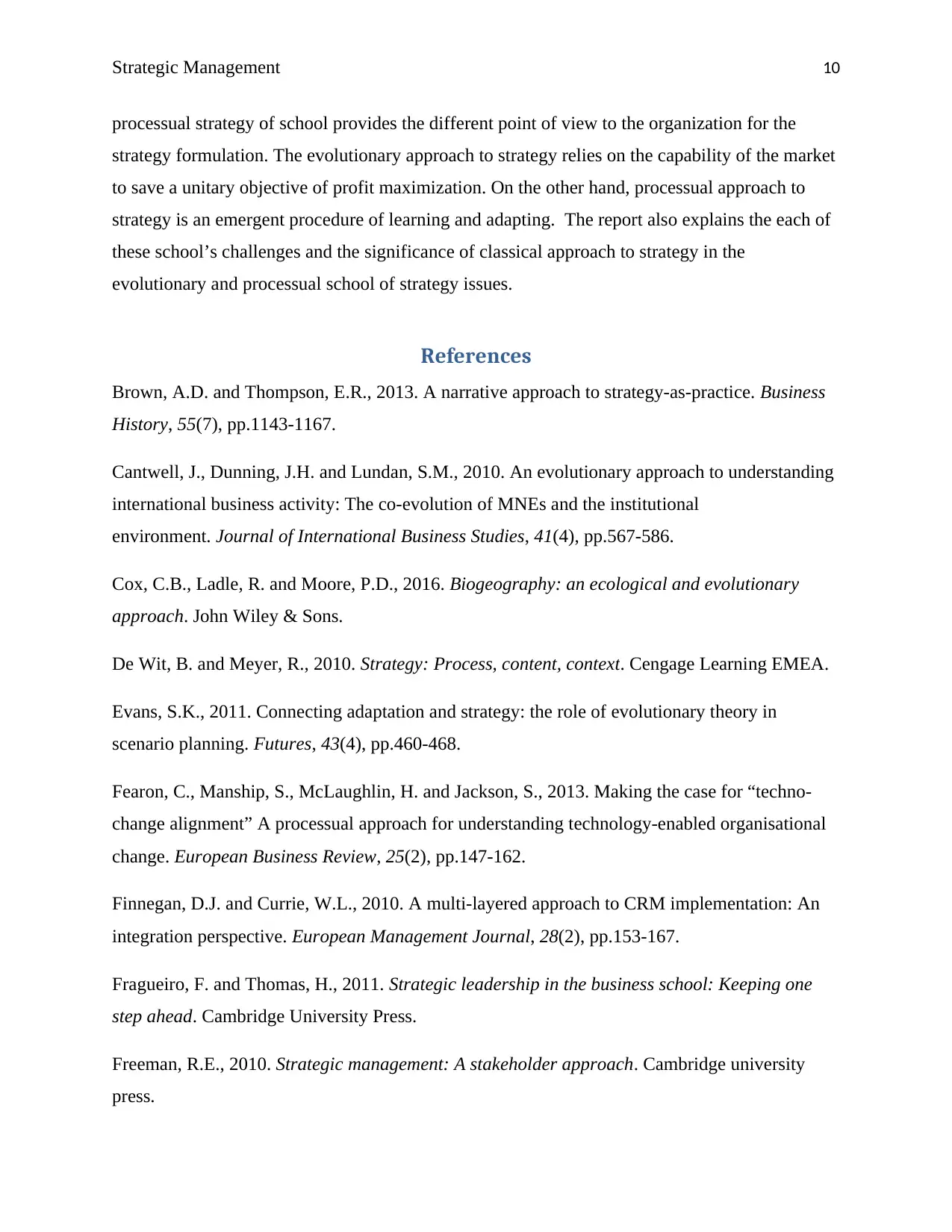
Strategic Management 10
processual strategy of school provides the different point of view to the organization for the
strategy formulation. The evolutionary approach to strategy relies on the capability of the market
to save a unitary objective of profit maximization. On the other hand, processual approach to
strategy is an emergent procedure of learning and adapting. The report also explains the each of
these school’s challenges and the significance of classical approach to strategy in the
evolutionary and processual school of strategy issues.
References
Brown, A.D. and Thompson, E.R., 2013. A narrative approach to strategy-as-practice. Business
History, 55(7), pp.1143-1167.
Cantwell, J., Dunning, J.H. and Lundan, S.M., 2010. An evolutionary approach to understanding
international business activity: The co-evolution of MNEs and the institutional
environment. Journal of International Business Studies, 41(4), pp.567-586.
Cox, C.B., Ladle, R. and Moore, P.D., 2016. Biogeography: an ecological and evolutionary
approach. John Wiley & Sons.
De Wit, B. and Meyer, R., 2010. Strategy: Process, content, context. Cengage Learning EMEA.
Evans, S.K., 2011. Connecting adaptation and strategy: the role of evolutionary theory in
scenario planning. Futures, 43(4), pp.460-468.
Fearon, C., Manship, S., McLaughlin, H. and Jackson, S., 2013. Making the case for “techno-
change alignment” A processual approach for understanding technology-enabled organisational
change. European Business Review, 25(2), pp.147-162.
Finnegan, D.J. and Currie, W.L., 2010. A multi-layered approach to CRM implementation: An
integration perspective. European Management Journal, 28(2), pp.153-167.
Fragueiro, F. and Thomas, H., 2011. Strategic leadership in the business school: Keeping one
step ahead. Cambridge University Press.
Freeman, R.E., 2010. Strategic management: A stakeholder approach. Cambridge university
press.
processual strategy of school provides the different point of view to the organization for the
strategy formulation. The evolutionary approach to strategy relies on the capability of the market
to save a unitary objective of profit maximization. On the other hand, processual approach to
strategy is an emergent procedure of learning and adapting. The report also explains the each of
these school’s challenges and the significance of classical approach to strategy in the
evolutionary and processual school of strategy issues.
References
Brown, A.D. and Thompson, E.R., 2013. A narrative approach to strategy-as-practice. Business
History, 55(7), pp.1143-1167.
Cantwell, J., Dunning, J.H. and Lundan, S.M., 2010. An evolutionary approach to understanding
international business activity: The co-evolution of MNEs and the institutional
environment. Journal of International Business Studies, 41(4), pp.567-586.
Cox, C.B., Ladle, R. and Moore, P.D., 2016. Biogeography: an ecological and evolutionary
approach. John Wiley & Sons.
De Wit, B. and Meyer, R., 2010. Strategy: Process, content, context. Cengage Learning EMEA.
Evans, S.K., 2011. Connecting adaptation and strategy: the role of evolutionary theory in
scenario planning. Futures, 43(4), pp.460-468.
Fearon, C., Manship, S., McLaughlin, H. and Jackson, S., 2013. Making the case for “techno-
change alignment” A processual approach for understanding technology-enabled organisational
change. European Business Review, 25(2), pp.147-162.
Finnegan, D.J. and Currie, W.L., 2010. A multi-layered approach to CRM implementation: An
integration perspective. European Management Journal, 28(2), pp.153-167.
Fragueiro, F. and Thomas, H., 2011. Strategic leadership in the business school: Keeping one
step ahead. Cambridge University Press.
Freeman, R.E., 2010. Strategic management: A stakeholder approach. Cambridge university
press.
Secure Best Marks with AI Grader
Need help grading? Try our AI Grader for instant feedback on your assignments.
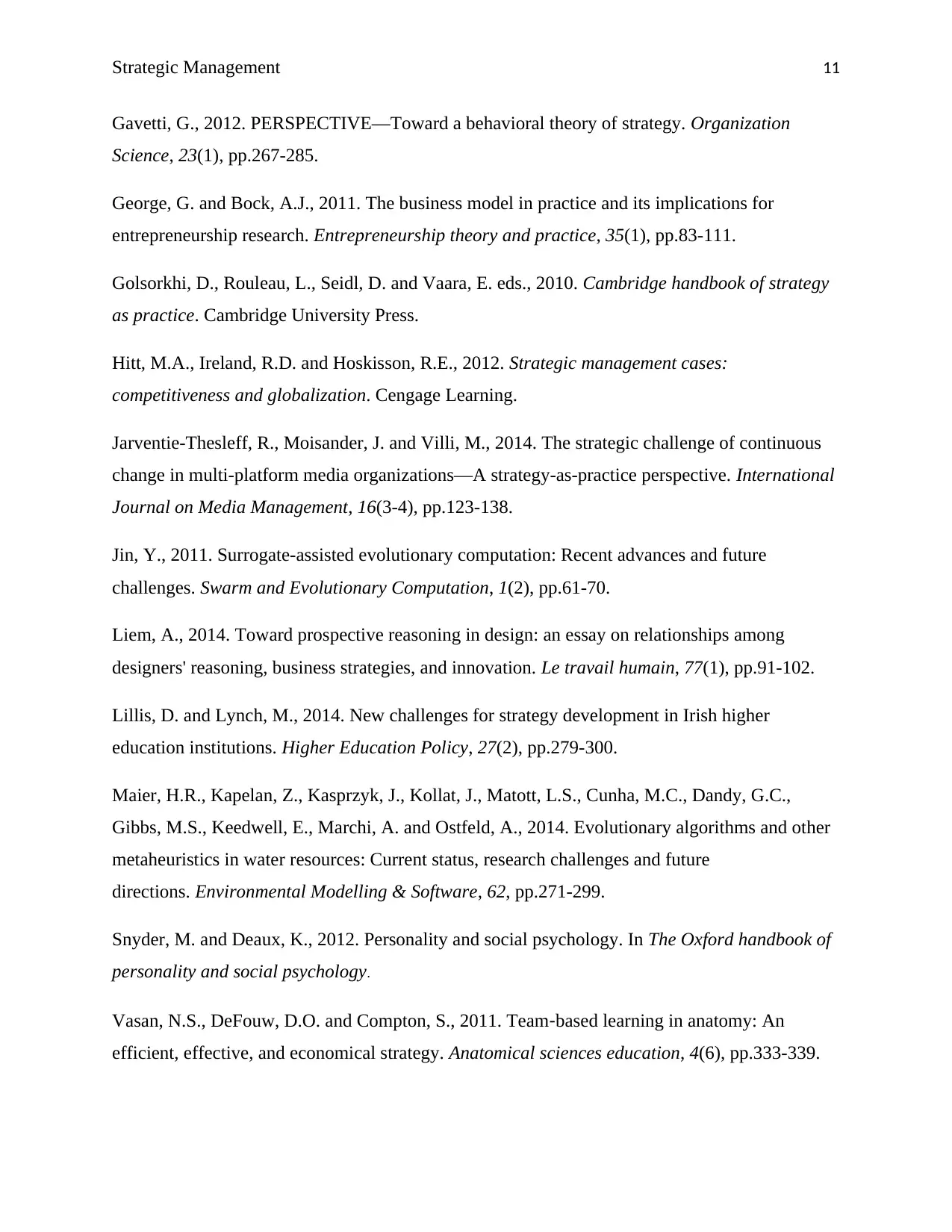
Strategic Management 11
Gavetti, G., 2012. PERSPECTIVE—Toward a behavioral theory of strategy. Organization
Science, 23(1), pp.267-285.
George, G. and Bock, A.J., 2011. The business model in practice and its implications for
entrepreneurship research. Entrepreneurship theory and practice, 35(1), pp.83-111.
Golsorkhi, D., Rouleau, L., Seidl, D. and Vaara, E. eds., 2010. Cambridge handbook of strategy
as practice. Cambridge University Press.
Hitt, M.A., Ireland, R.D. and Hoskisson, R.E., 2012. Strategic management cases:
competitiveness and globalization. Cengage Learning.
Jarventie-Thesleff, R., Moisander, J. and Villi, M., 2014. The strategic challenge of continuous
change in multi-platform media organizations—A strategy-as-practice perspective. International
Journal on Media Management, 16(3-4), pp.123-138.
Jin, Y., 2011. Surrogate-assisted evolutionary computation: Recent advances and future
challenges. Swarm and Evolutionary Computation, 1(2), pp.61-70.
Liem, A., 2014. Toward prospective reasoning in design: an essay on relationships among
designers' reasoning, business strategies, and innovation. Le travail humain, 77(1), pp.91-102.
Lillis, D. and Lynch, M., 2014. New challenges for strategy development in Irish higher
education institutions. Higher Education Policy, 27(2), pp.279-300.
Maier, H.R., Kapelan, Z., Kasprzyk, J., Kollat, J., Matott, L.S., Cunha, M.C., Dandy, G.C.,
Gibbs, M.S., Keedwell, E., Marchi, A. and Ostfeld, A., 2014. Evolutionary algorithms and other
metaheuristics in water resources: Current status, research challenges and future
directions. Environmental Modelling & Software, 62, pp.271-299.
Snyder, M. and Deaux, K., 2012. Personality and social psychology. In The Oxford handbook of
personality and social psychology.
Vasan, N.S., DeFouw, D.O. and Compton, S., 2011. Team‐based learning in anatomy: An
efficient, effective, and economical strategy. Anatomical sciences education, 4(6), pp.333-339.
Gavetti, G., 2012. PERSPECTIVE—Toward a behavioral theory of strategy. Organization
Science, 23(1), pp.267-285.
George, G. and Bock, A.J., 2011. The business model in practice and its implications for
entrepreneurship research. Entrepreneurship theory and practice, 35(1), pp.83-111.
Golsorkhi, D., Rouleau, L., Seidl, D. and Vaara, E. eds., 2010. Cambridge handbook of strategy
as practice. Cambridge University Press.
Hitt, M.A., Ireland, R.D. and Hoskisson, R.E., 2012. Strategic management cases:
competitiveness and globalization. Cengage Learning.
Jarventie-Thesleff, R., Moisander, J. and Villi, M., 2014. The strategic challenge of continuous
change in multi-platform media organizations—A strategy-as-practice perspective. International
Journal on Media Management, 16(3-4), pp.123-138.
Jin, Y., 2011. Surrogate-assisted evolutionary computation: Recent advances and future
challenges. Swarm and Evolutionary Computation, 1(2), pp.61-70.
Liem, A., 2014. Toward prospective reasoning in design: an essay on relationships among
designers' reasoning, business strategies, and innovation. Le travail humain, 77(1), pp.91-102.
Lillis, D. and Lynch, M., 2014. New challenges for strategy development in Irish higher
education institutions. Higher Education Policy, 27(2), pp.279-300.
Maier, H.R., Kapelan, Z., Kasprzyk, J., Kollat, J., Matott, L.S., Cunha, M.C., Dandy, G.C.,
Gibbs, M.S., Keedwell, E., Marchi, A. and Ostfeld, A., 2014. Evolutionary algorithms and other
metaheuristics in water resources: Current status, research challenges and future
directions. Environmental Modelling & Software, 62, pp.271-299.
Snyder, M. and Deaux, K., 2012. Personality and social psychology. In The Oxford handbook of
personality and social psychology.
Vasan, N.S., DeFouw, D.O. and Compton, S., 2011. Team‐based learning in anatomy: An
efficient, effective, and economical strategy. Anatomical sciences education, 4(6), pp.333-339.

Strategic Management 12
1 out of 12
Related Documents
Your All-in-One AI-Powered Toolkit for Academic Success.
+13062052269
info@desklib.com
Available 24*7 on WhatsApp / Email
![[object Object]](/_next/static/media/star-bottom.7253800d.svg)
Unlock your academic potential
© 2024 | Zucol Services PVT LTD | All rights reserved.





